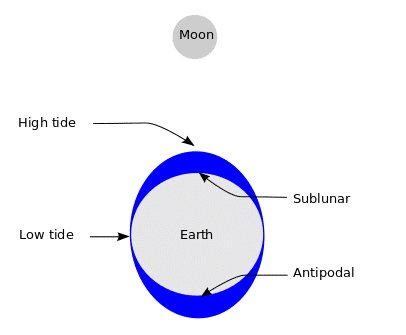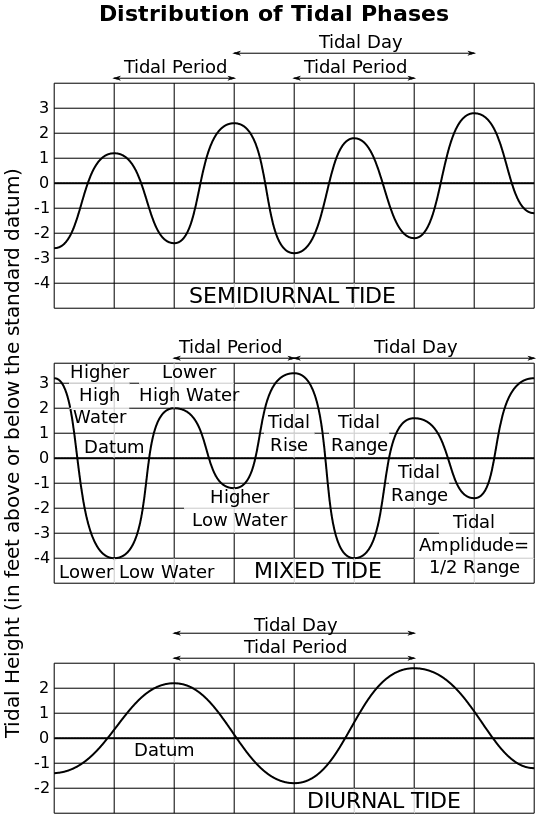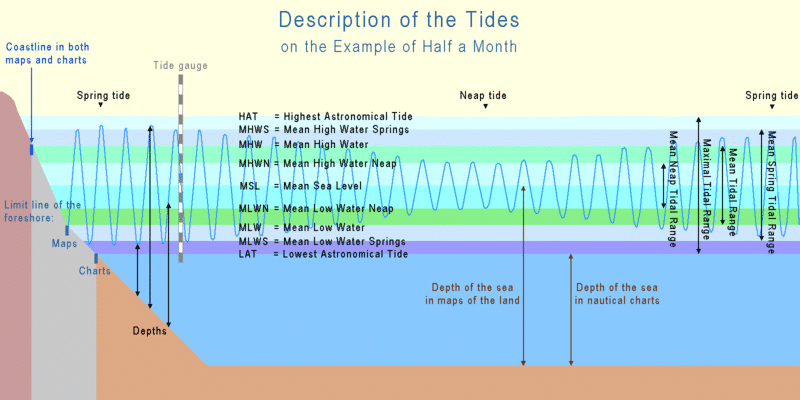
Tides are the rise and fall of sea levels caused by the combined effects of the gravitational forces exerted by the Moon and the Sun and the rotation of Earth.
The times and amplitude of tides at any given locale are influenced by the alignment of the Sun and Moon, by the pattern of tides in the deep ocean, by the amphidromic systems of the oceans, and the shape of the coastline and near-shore bathymetry (see Timing). Some shorelines experience a semi-diurnal tide—two nearly equal high and low tides each day. Other locations experience a diurnal tide—only one high and low tide each day. A “mixed tide”—two uneven tides a day, or one high and one low—is also possible.

Tides vary on timescales ranging from hours to years due to a number of factors. To make accurate records, tide gauges at fixed stations measure water level over time. Gauges ignore variations caused by waves with periods shorter than minutes. These data are compared to the reference (or datum) level usually called mean sea level.
Tide changes proceed via the following stages:
- Sea level rises over several hours, covering the intertidal zone; flood tide.
- The water rises to its highest level, reaching high tide.
- Sea level falls over several hours, revealing the intertidal zone; ebb tide.
- The water stops falling, reaching low tide.
Oscillating currents produced by tides are known as tidal streams. The moment that the tidal current ceases is called slack water or slack tide. The tide then reverses direction and is said to be turning. Slack water usually occurs near high water and low water. But there are locations where the moments of slack tide differ significantly from those of high and low water.
Tides are commonly semi-diurnal (two high waters and two low waters each day), or diurnal (one tidal cycle per day). The two high waters on a given day are typically not the same height (the daily inequality); these are the higher high water and the lower high water in tide tables. Similarly, the two low waters each day are the higher low water and the lower low water. The daily inequality is not consistent and is generally small when the Moon is over the equator.
Definitions
From the highest level to the lowest:
- Highest astronomical tide (HAT) – The highest tide which can be predicted to occur. Note that meteorological conditions may add extra height to the HAT.
- Mean high water springs (MHWS) – The average of the two high tides on the days of spring tides.
- Mean high water neaps (MHWN) – The average of the two high tides on the days of neap tides.
- Mean sea level (MSL) – This is the average sea level. The MSL is constant for any location over a long period.
- Mean low water neaps (MLWN) – The average of the two low tides on the days of neap tides.
- Mean low water springs (MLWS) – The average of the two low tides on the days of spring tides.
- Lowest astronomical tide (LAT) and Chart Datum (CD) – The lowest tide which can be predicted to occur. Modern charts use this as the chart datum. Note that under certain meteorological conditions the water may fall lower than this meaning that there is less water than shown on charts.
